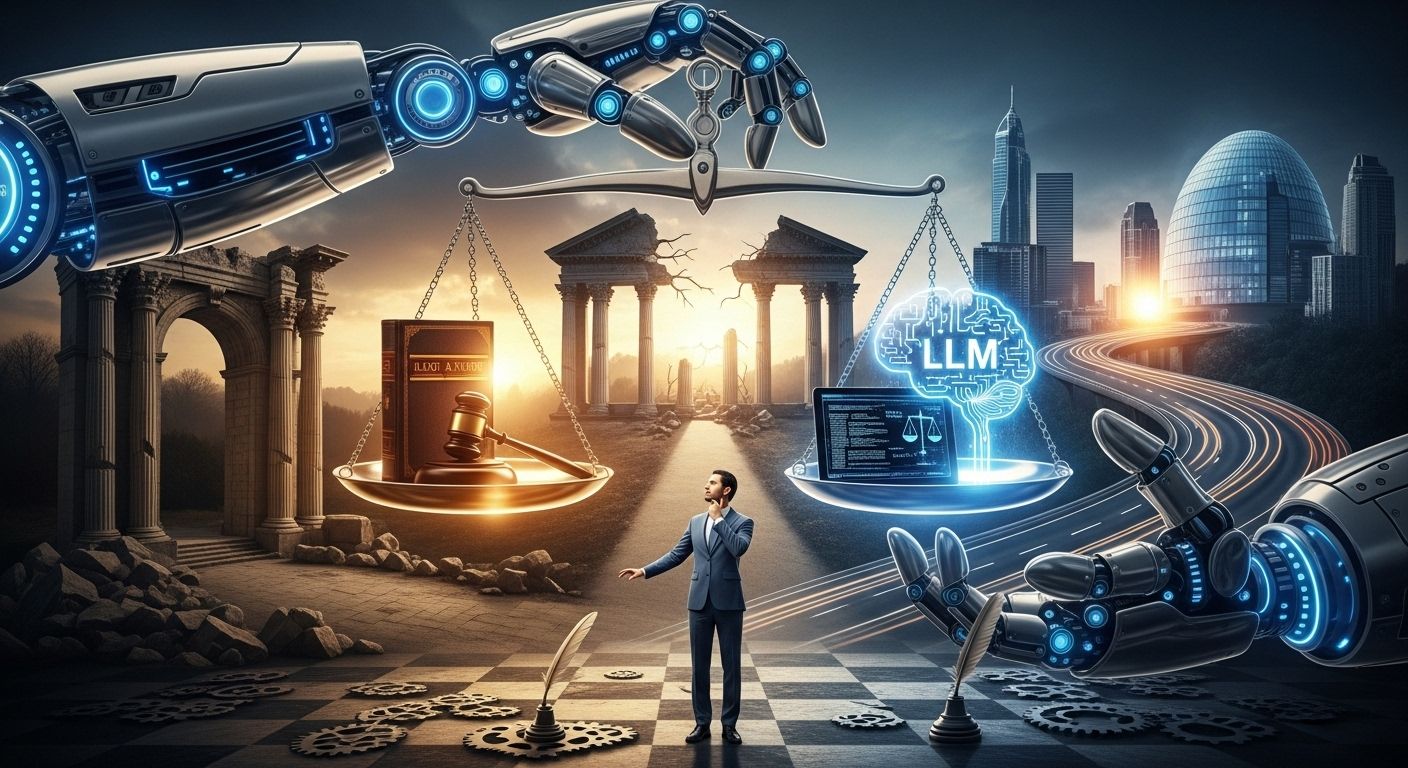The Legal Profession at a Crossroads: A Threat or an Opportunity?
Artificial intelligence (AI) that generates sophisticated text or other forms of output, often indistinguishable from human creation, has ceased to be a topic of science fiction and has become a tangible reality permeating all areas of professional life. The traditionally conservative field of law is no exception. Are lawyers in danger? The aim of this post is not to offer a simple answer but to analyze whether this technological shift represents an existential threat for Czech lawyers or rather an unprecedented opportunity for transformation and growth. For simplicity, I will use the term AI in this text to refer to generative language models like ChatGPT or Gemini.

The Dichotomy of AI in Law: Threat vs. Opportunity
Understanding the impact of this technology on legal practice requires recognizing its fundamental duality. It is not a clearly positive or negative technology; its influence is determined by how it is used and the degree of critical thinking with which its outputs are accepted.
AI as an Accelerator of Efficiency and Quality: The Arguments FOR
The main argument for using AI tools in the legal profession and other legal services is its ability to dramatically increase efficiency and free up human potential for tasks requiring higher cognitive skills.
- Automation of routine tasks: Legal research, case law analysis, contract review, or generating first drafts of documents.
- Increased productivity: Freeing up capacity for higher value-added work—strategy, negotiation, and client communication.
- Improved quality and predictive analysis: Detecting inconsistencies, reducing the risk of errors, and predicting dispute outcomes based on data.
Risks and Ethical Challenges: The Arguments AGAINST
The uncritical adoption of AI is associated with serious risks that can threaten not only individual cases but also the integrity of the entire profession.
- Factual unreliability and "hallucinations": AI can invent facts, cite non-existent case law, or refer to repealed laws, although there has been a noticeable improvement in this area in recent years.
- Lack of contextual and emotional understanding: AI lacks human judgment, empathy, and the ability to understand the subtle nuances of interpersonal relationships, despite the claims of its providers.
- Threat to professional duties: Inputting sensitive information directly conflicts with the duty of confidentiality. Furthermore, the full responsibility for providing legal services always lies with the lawyer, not the software.
AI won't replace humans. But people who use it will replace those who don't.
Practical Impacts of AI on Legal Practice in the Czech Republic
Most Czech and Slovak law firms are already using AI in some form. Specialized tools are emerging on the market, changing daily work and the structure of the legal market.
- Threat to junior positions: Automation most significantly affects tasks performed by interns, trainee lawyers, and even junior associates.
- Strengthening the role of senior lawyers: The role of seniors is shifting towards supervision, strategic planning, and final review of AI outputs.
- Changing business models: The pressure for efficiency is forcing firms to move from hourly rates to project-based pricing or value-based fees.
Regulatory and Ethical Framework in the Czech Republic
The Czech Bar Association (ČAK) has issued a statement emphasizing that AI is merely a tool and that the lawyer always bears full responsibility. The duty of confidentiality has absolute priority. At the European level, the Artificial Intelligence Act (AI Act) is being introduced, which establishes a risk-based approach. Most tools in the legal profession will fall into the minimal-risk category, where the key obligation will be transparency. However, given the highly specialized nature of the work, it is strongly recommended to implement proposed approaches such as human-in-the-loop or input/output management.
| Risk | Description of the Risk in a Legal Context | Mitigation Strategies and Recommended Practices |
|---|---|---|
| Factual Errors and "Hallucinations" | Generating incorrect legal information, citing non-existent case law. | Never copy without verification; use specialized legal tools; implement a two-phase review process. |
| Breach of Attorney-Client Confidentiality | Inputting sensitive client data into AI models. | Prohibit the use of AI for client data; use enterprise licenses and on-premise solutions; anonymize data. |
| Loss of Critical Skills | Over-reliance on AI can lead to the atrophy of analytical and research skills. | Educate lawyers to understand AI as an assistant, not a substitute; change the educational model. |
| Legal and Ethical Responsibility | Ambiguity regarding liability for AI errors. However, according to professional regulations, it is always the lawyer. | Clear internal guidelines; verification of professional liability insurance; documentation and audit trail. |
Conclusion: How to Adapt and Thrive?
Passive waiting is not a sustainable strategy. The future of the legal profession lies in the "centaur" model—a symbiosis of human intuition and strategic thinking that directs the immense computational power of AI. The successful lawyer of the future will not be the one who tries to beat AI, but the one who learns to "ride" it best.
- For individuals: Proactively educate yourself, develop "human" skills (critical thinking, empathy), and build a personal brand.
- For law firms: Develop an AI strategy, invest in secure technologies and training, and revise the business model.
- For educational institutions: Modernize curricula and include legal technology and data literacy in teaching.